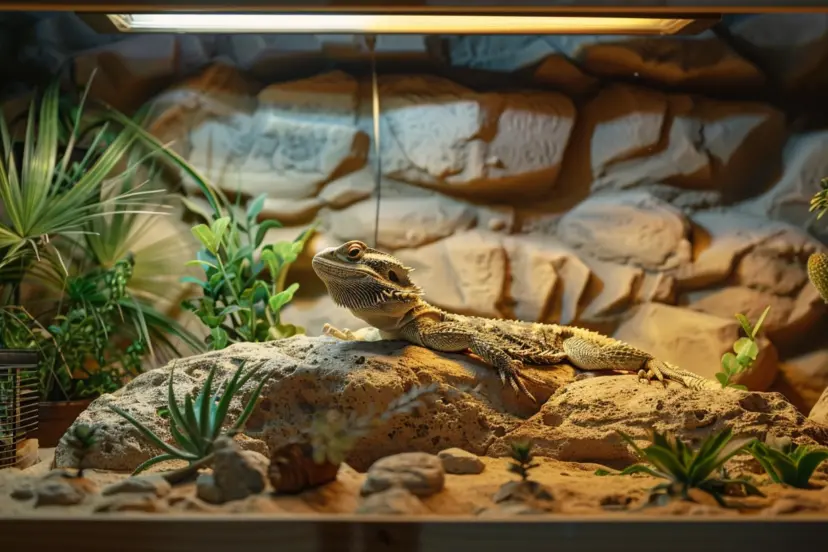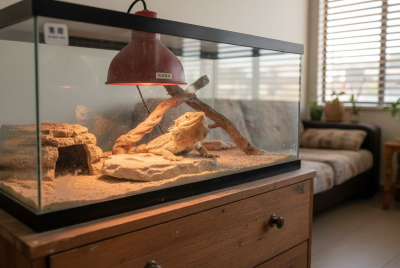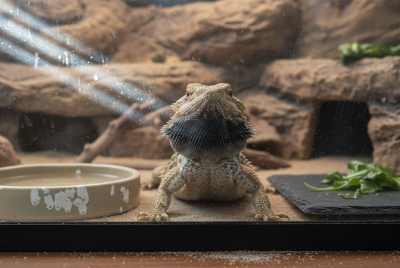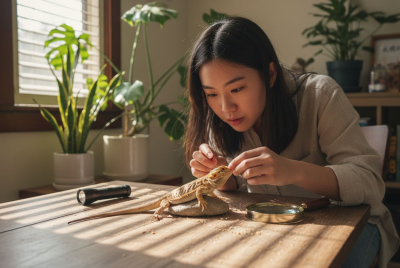Bearded Dragon Enclosure: The Ultimate Guide
So, you’ve brought home a bearded dragon—or you’re thinking about getting one. Congratulations! These scaly companions are fascinating pets, but their happiness and health depend largely on the environment you provide for them. Let’s dive into what makes the perfect bearded dragon enclosure and how you can ensure your dragon is comfortable, safe, and thriving.
Why a Proper Enclosure is Crucial for Bearded Dragons
If there’s one thing every bearded dragon owner needs to know, it’s that their enclosure plays a major role in their overall well-being. Creating a proper habitat doesn’t just look good—it’s essential for their physical and mental health.
Mimicking Their Natural Habitat
In the wild, bearded dragons live in the arid, desert regions of Australia. They spend a lot of time basking under the sun, climbing on rocks, and hiding in crevices. Your goal? Mimic this natural habitat as closely as possible. This way, your dragon will feel more at home, which leads to reduced stress and a healthier, happier life.
Preventing Health Issues
A poorly designed enclosure can lead to numerous health problems for your bearded dragon, including metabolic bone disease, respiratory infections, and stress-related issues. Proper lighting, temperature, and space all play vital roles in preventing these ailments.
Choosing the Right Enclosure Size
The size of your bearded dragon’s enclosure is incredibly important. Not only does it give your pet room to explore, but it also helps maintain proper temperature gradients (more on that later). So, how big should it be?
Size Recommendations for Hatchlings, Juveniles, and Adults
For a hatchling or juvenile bearded dragon (under 10 inches long), a 20-gallon tank might be sufficient for the short term. However, as your dragon grows, you’ll need a larger space. For an adult bearded dragon, you’ll want a minimum of a 85-gallon tank, but larger is always better. Trust me, your dragon will appreciate the extra room to roam!
Why Bigger is Always Better
Bearded dragons are active creatures that love to explore. A larger enclosure gives them the opportunity to move around more, bask in different spots, and engage in their natural behaviors. While the minimum size for adults is 75 gallons, aim for 100 gallons or more if possible. They’ll thank you with healthier behavior and less boredom.
The Best Substrates for Bearded Dragons
The type of substrate you use in your bearded dragon’s enclosure is crucial to their health and safety. Not all substrates are created equal, so it’s essential to choose the right one.
Safe Substrates
Some of the best options for substrate include reptile carpet, tile, or paper towels (for hatchlings). These are all easy to clean and safe for your dragon. You might also consider bioactive substrates, which mimic the natural environment more closely and allow for a mini ecosystem inside the enclosure.
Substrates to Avoid
Avoid loose substrates like sand, wood shavings, or crushed walnut shells. These can lead to impaction—a serious and potentially fatal condition where your dragon accidentally ingests the substrate and it clogs their digestive system. Stick with safer, more solid options.
Temperature and Lighting Essentials
Bearded dragons are cold-blooded reptiles, which means they rely on their environment to regulate their body temperature. Getting the temperature and lighting right is crucial for their health.
UVB Lighting: Why It’s Important
UVB lighting is an absolute must for bearded dragons. Without it, they can’t properly metabolize calcium, leading to metabolic bone disease. Make sure your enclosure has a UVB light that covers at least two-thirds of the enclosure. Replace the bulb every 6-12 months, as its effectiveness decreases over time.
Temperature Gradient
Creating a temperature gradient is essential. Bearded dragons need a basking spot that is much hotter than the cool side of the tank. This allows them to move between temperatures as needed.
Basking and Cool Areas
For the basking area, aim for a temperature of 95-105°F. On the cooler side of the enclosure, the temperature should be around 75-85°F. This gradient mimics the natural temperature shifts they would experience in the wild and helps regulate their digestion and metabolism.
Nighttime Heat and Lighting
At night, it’s okay for temperatures to drop, but they shouldn’t fall below 65°F. Avoid using bright lights at night, as it can disturb your dragon’s sleep cycle. If you need extra warmth, use a ceramic heat emitter that doesn’t emit light.
Creating a Comfortable Environment
It’s not just about size and temperature—your bearded dragon’s enclosure needs to be stimulating and comfortable. Here’s what to include.
Furnishings: What to Include
Add elements like basking rocks, branches for climbing, and textured surfaces for grip. These accessories mimic the natural environment and provide your dragon with the opportunity to explore and exercise.
Hiding Spots and Climbing Areas
Your bearded dragon enclosure needs a few places to hide. This helps them feel secure, especially when they want to retreat from light or heat. Include at least one hideout on the cool side of the enclosure and another near the basking area. Also, add climbing spots like rocks and branches for extra enrichment.
Cleaning and Maintenance Tips
A clean enclosure is a healthy enclosure. Here’s how to keep your dragon’s home fresh and safe.
Daily Spot Cleaning
Each day, remove any waste or uneaten food from the enclosure. Bearded dragons can be messy, and leaving waste in the tank can lead to bacterial growth, which can make your dragon sick.
Deep Cleaning and Disinfecting
Once a month (or as needed), do a deep clean of the entire enclosure. Remove all items, clean them thoroughly with reptile-safe disinfectant, and replace the substrate if necessary. This will help prevent the buildup of bacteria and parasites.
Common Mistakes to Avoid
When setting up your bearded dragon’s enclosure, there are a few common mistakes to steer clear of.
Using Unsafe Materials
Never use loose substrates like sand, as mentioned earlier, but also be careful with certain woods and plastics that can emit harmful chemicals or splinter.
Inadequate Ventilation
Make sure your dragon’s enclosure has proper airflow. Stagnant air can lead to humidity problems and respiratory issues. Most enclosures have a mesh top or ventilation slits to ensure fresh air circulates.
Conclusion
Setting up the perfect bearded dragon enclosure takes time, effort, and a bit of creativity. But trust me, it’s worth it! When you provide your bearded dragon with a comfortable, safe, and enriching environment, you’re not only ensuring their health but also allowing them to thrive. From selecting the right size tank to getting the lighting and temperature just right, every detail matters. Now, get ready to enjoy watching your bearded dragon explore, bask, and enjoy their new home!
FAQs
- How often should I clean my bearded dragon’s enclosure? Spot clean daily and deep clean the entire enclosure at least once a month.
- Can I use sand in my bearded dragon’s tank? It’s best to avoid sand as it can lead to impaction. Opt for solid substrates like reptile carpet or tile.
- What temperature should a bearded dragon’s enclosure be? The basking area should be around 95-105°F, with the cool side ranging from 75-85°F.
- Do I need a UVB light for my bearded dragon? Yes! UVB lighting is essential for calcium metabolism and preventing metabolic bone disease.
- How big should my bearded dragon’s tank be? Aim for a minimum of 75 gallons for adults, though bigger is always better!




